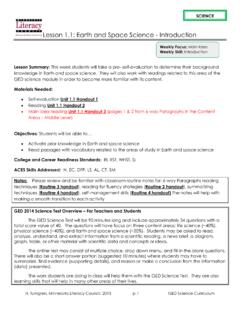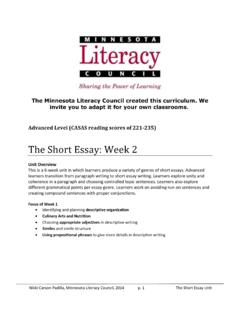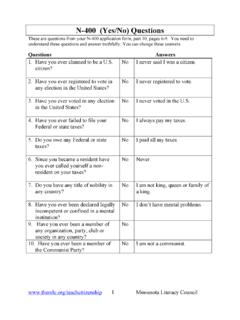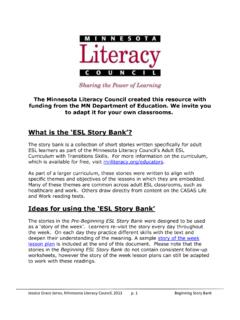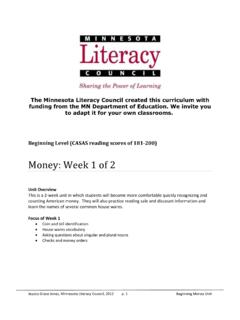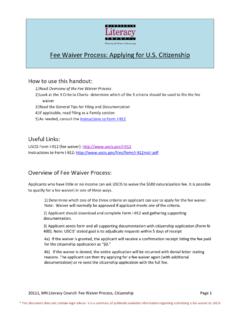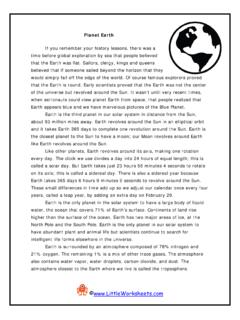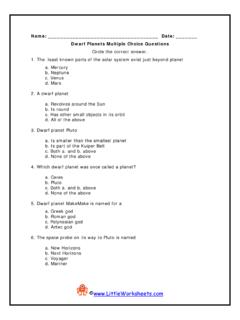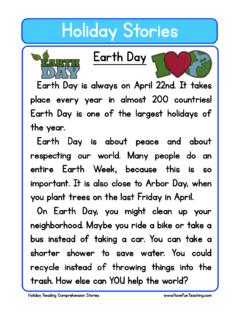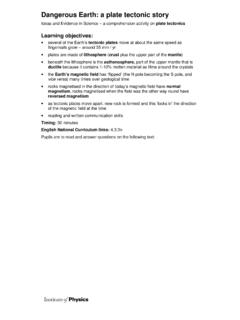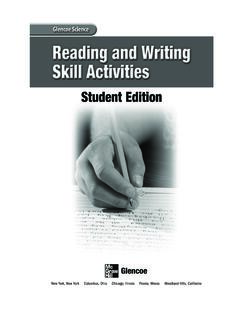Transcription of Unit 1.8: Earth and Space Science Planets & Stars
1 Unit : Earth and Space Science Planets & Stars H. Turngren, Minnesota Literacy Council, 2013 GED Science Curriculum Science Lesson Summary: This week students will continue to learn about the makeup of the Cosmos, specifically the solar system. Students will also review using a Venn diagram to compare and contrast visual information. Materials Needed: Reading on Our Solar System Unit handout 1 Compare and Contrast Visual Information Unit Handout 2 Homework Unit Handout 3 (6-Way Paragraphs, Middle Level, pages 26-27) Objectives: Students will be able Understand key components or parts of the solar system Name the main differences in the inner and outer Planets College and Career Readiness Standards: RI, RST, WHST ACES Skills Addressed: DFP, LS, AL, CT, SM, N Notes: Explain to students the importance reading for comprehension.
2 It is the reason for most reading we do at home, at work, and in college. Remind students that while they are reading new material, they need to comprehend what they are reading. If they do not understand a sentence or an idea, they should reread it. While they are reading for comprehension, they should also monitor their time. That is to say, they should skim and scan for information to answer the questions. Reading quickly for comprehension is a skill needed on many modules or portions of the GED test as well as a college skill. Remind students that the next lesson, Unit , will have a review of material covered over the past 7 9 weeks in Earth and Space Science . Ask students to take some time to review handouts to prepare for the GED-like questions. Assure newer students that they will be able to gauge their knowledge with the review questions and determine what areas they may need to study further.
3 Also, please note that Routine 4 is referenced in this lesson. Weekly Focus: Reading for Comprehension Weekly Skill: Compare and Contrast Unit : Earth and Space Science Planets & Stars H. Turngren, Minnesota Literacy Council, 2013 GED Science Curriculum Science GED 2014 Science Test Overview For Teachers and Students The GED Science Test will be 90 minutes long and include approximately 34 questions with a total score value of 40. The questions will have focus on three content areas: life Science (~40%), physical Science (~40%), and Earth and Space Science (~20%). Students may be asked to read, analyze, understand, and extract information from a scientific reading, a news brief, a diagram, graph, table, or other material with scientific data and concepts or ideas.
4 The online test may consist of multiple choice, drop down menu, and fill-in-the-blank questions. There will also be a short answer portion (suggested 10 minutes) where students may have to summarize, find evidence (supporting details), and reason or make a conclusion from the information (data) presented. The work students are doing in class will help them with the GED Science Test. They are also learning skills that will help in many other areas of their lives. Activities: Warm-Up: Quick Scan of Our Solar System Time: 10 minutes As students enter the class, have students write in their journals, on a piece of notebook paper, or discuss with small groups the following: What do you know about the Solar System? Note: write the question on the board or overhead.
5 Circulate while students are writing. If students seems to be stuck with this question, try to prompt them with questions about what they already know about the Solar System from what they have studied as well as what they may have read or watch on television. Prompt students with questions such as: How many Planets are in the solar system and what are their names? What is the name of our galaxy? etc. Activity 1: Reading for Comprehension: Our Solar System (Unit Handout 1) Time: 40 - 50 minutes 1) Distribute Unit Handout 1 a to students. 2) discuss with students that when reading for comprehension, there are many strategies to use: read the title to predict what the reading is about; look at the words in bold and then search for their definitions; if there are images, look at them to get a better understanding; while reading remember to ask What is this all about?
6 3) Have students read the passage and answer the questions independently. In the past this has been group work (presentations), however, now students are going to prepare to work independently. This is a way to prepare them for the Unit 1 review in which they will have to read and answer questions independently also. 4) Circulate class while they are reading to make sure they understand the information presented and see if there are any questions 5) review answers as a whole class. Ask students to point out what evidence or information led them to the answer they choose. If their answer is not correct, review the information to make sure they understand it correctly. 6) If there is extra time, have students read passage in pairs to promote reading fluency. Break: 10 minutes Unit : Earth and Space Science Planets & Stars H.
7 Turngren, Minnesota Literacy Council, 2013 GED Science Curriculum Science Activity 2: Compare and Contrast planet Charts & Data with a Venn Diagram (Unit Handout 2) Time: 40 minutes 1) Hand out (Unit Handout 2) to students. 2) Explain how compare and contrast to students and how to use Venn diagram. 3) Explain to students that they should examine the two charts (Inner Planets & Outer Planets ) and use the Venn diagram to note what is the same and what is different in the charts. Students should work individually then share their Venn diagrams with pairs or table groups. Circulate the room to assist students with the activity, especially new students who may not have worked with a Venn diagram. 4) When they are finished with the Venn diagram, students will have to examine the chart with planet data to answer questions that follow.
8 Discuss with students that they may have to read charts on a GED Science or Social Studies test with a lot of information that is not needed in a response. They should practice skimming and scanning to find the requested information. 5) Review answers as a whole class. Ask students to explain or discuss how they reached their answer. Ask them what evidence did they use to reach their conclusion. 6) Ask for students to share their answers if they would like. Remind students that there can be different possible answers. Wrap-Up: Summarize Time: 5 - 10 minutes Have students turn to a partner (or write in their journals) about what they have learned today about our solar system, Planets , and Stars . Ask them to discuss one thing new they learned today. Another option is to have students come up with one question or wondering they still have about the subject that they could research and report back to the class.
9 Note: Use Routine 4 Handout: Summarizing Extra Work/Homework: Black Holes (Unit Handout 3) Time: 20 minutes outside of class Students can read and answer questions: 6-way Paragraphs Middle Level, pages 26 - 27) Black Holes. This is an excellent opportunity for students to review some of today s material in an independent manner. It could also be used as a way to get new or absent students caught up with the lesson. Differentiated Instruction/ELL Accommodation Suggestions Activity If some student groups finish early, they can use the time to practice summarizing a multi-paragraph reading. Unit Handout 1 You may need to explicitly instruct on how to use a Venn diagram. One example is to have two students stand at the front of the room. Ask for what is the same ( : students, study for GED, live in MN,) and what is different ( : male, from Africa, married, etc.
10 And put the information in a Venn diagram on the board. Explain how this helps to organize information from passages in order to make a conclusion with evidence. Unit Handout 2 Unit : Earth and Space Science Planets & Stars H. Turngren, Minnesota Literacy Council, 2013 GED Science Curriculum Science Online Resources: NASA: Suggested Teacher Readings: GED Testing Service GED Science Item Sample (to get an idea of what the test may be like) Assessment Guide for Educators: A guide to the 2014 assessment content from GED Testing Service: Minnesota is getting ready for the 2014 GED test! website with updated information on the professional development in Minnesota regarding the 2014 GED.

